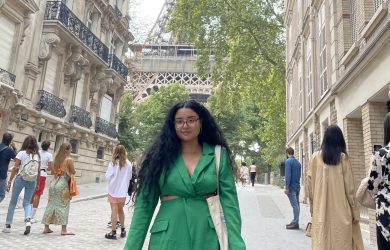
Jonathan Hollander on moving from research to policy to a biorefining start-up.
A lot of what I am doing now has come out of my time at Cambridge where I was trying to bridge the gap between academic research and practical change. Cambridge was a critical place for my intellectual development.
Jonathan Hollander
Jonathan Hollander [2006] has spent his career trying to find practical ways of reducing our energy use. In doing so he has run the gamut of research, policy and practice since he left the University of Cambridge where he studied how to make light-emitting diodes more efficient.
He is now working for a start-up company in biorefining, having founded his own energy think tank at Cambridge, and has brought in more than $1m in funding to bring the company’s biorefinery project to commercial usage.
Jonathan developed an entrepreneurial approach to life at an early age. Born in Syracuse in New York State, he interned for MTV in New York while he was at high school where he helped with automating daily tasks. He also worked for an optometrist and, in the pre-app days, developed a platform which allowed people who needed new frames for their glasses to see them from various angles. It involved creating the software and hardware for a built-in camera with a database of lenses which was capable of facial mapping.
As a child he admits to being fascinated by how things worked and was always taking things apart to understand what went into their design. His father, an engineer turned manager, spurred him on and was keen to encourage his son in the sciences. He would regularly take him to museums and encourage him to play maths games on long car journeys to New York. Jonathan loved the “hardcore sciences” at school and knew he wanted to work with devices. “I knew I wouldn’t be happy as a theorist. I wanted to touch the technology and build it,” he says.
University
When he went to the University of Illinois Jonathan had to refine which area of science he wanted to focus on. He chose material sciences as it brought together all the sciences he was interested in and he decided to focus on optical electronics, specifically gallium nitride. While at university, he did a series of summer internships at Syracuse University, working on ultra thin films and atomic scale layers of different metals and metal alloys. “I was looking at how current flows through them. As computers get smaller the wires that link elements in them are smaller and smaller. They reach a threshold at which there is too much risk of leakage. I wanted to find a solution to this problem,” he says.
He worked well under the pressure of short-term projects which he says pushed him to get things done. His goal was to get papers published on his research, which he did. He also took part in an organised programme at the University of California Santa Barbara working with the Nobel Prize winner Shuji Nakamura on energy efficient lighting. “I wanted to learn more about how to develop blue light emitting diode technology,” he said. “I could also see the commercial opportunities.”
The following summer he took part in an optical materials programme at MIT, studying colour transition technologies such as E Ink.
Cambridge
By this point he knew he wanted to do a PhD and that LEDs were his major interest. He says Illinois had focused on the science and MIT on commercialisation. He wanted a different approach. He emailed Professor Sir Colin Humphreys at the University of Cambridge about his research proposal and was accepted to do a masters in semi-conductor physics in 2005 on a Winston Churchill Scholarship. He intended to return home after finishing that, but won a Gates Cambridge Scholarship to do his PhD in Materials Science and Metallurgy on gallium nitride semiconductor light-emitting devices. “Cambridge became my world,” he says simply.
He attended a lot of conferences on semi-conductors – 20 in three years – and travelled the world, extending the work he had done at the University of California Santa Barbara which was becoming a fertile area for research. “When I started at Cambridge we were just doing a few tests in the laboratory where I worked and by the end of my PhD it had become one of the four major focuses of our research,” he says.
His research focused on how to make LED more efficient through looking at how to maintain atom symmetry when LED crystals are moved.
When he finished his degree he had a choice to make. “I could either continue to work on improving the efficiency of LED by around 1% and save X amount of energy or I could work in policy, trying to convince the UK government to mandate the use of LEDS more widely which would save much more energy,” he says.
He had made a lot of contacts through the University and decided to set up the E3 Foundation, an energy policy think tank, in 2009 to develop ideas on how to promote energy efficiency better and make a good business case for doing so. His role embraced everything from fundraising, brand management, event planning and long-term strategic goal setting to creating a multi-channel marketing campaign which led to a surge in public interest and press inquiries.
After three years at the E3 Foundation, Jonathan wanted to get more experience in business since he realised change would only come through three different processes – innovation, driven by research, policy change and getting the business community to develop the technology at a price that would make energy efficient products sell.
Business development
He decided to focus more on understanding the business side of the equation and in 2012 moved back to the US to work as business development manager at Firmstep, a business which helps local government to build and deliver better services. There he managed new product development of IT solutions for the delivery of web-based citizen services, built a business to business sales pipeline and conducted market research to generate new business opportunities. He stayed there for six months before taking up a post as Senior Educational Specialist and Adjunct Assistant Professor at the SUNY College of Environmental Science and Forestry in New York, the US’ oldest school dedicated to the study of the environment, developing renewable technologies and building a sustainable future.
His role involved developing online courses for a new industry-focused certificate on radiation curing of polymer coatings. While at SUNY ESF he met a bioprocess engineering fellow who had started up a company which was still in research and development mode and had not yet begun the commercialisation process. It aims to develop biorefinery technology that is distinctly different from bio-chemical and thermo-chemical processes that destroy or discard chemical intermediaries. Jonathan had experience of building coalitions between researchers, policymakers and business. He joined Applied Biorefinery Sciences in 2013 as Director of Business Development and says he entered “a whirlwind of learning”.
“I wouldn’t trade it for anything,” he says, “but working for a start-up is challenging. You never know where you next pay cheque is coming from so it is hard to advance other things in your life. There’s a lot of uncertainty from day to day and I deal well with that and the goal of our technology is one I am fully committed to. It’s about creating a sustainable economy that is more energy efficient. It is what has driven all my research.”
Biorefining
Biorefining is similar to oil refining. You start with a crude material and through a process of chemical and physical interactions you purify it and separate it into different products – for instance, with oil you have petrol, kerosene, lubricants, plastics and more. In biorefining products include renewable fuels and bioplastics. Jonathan says it is also about creating a new manufacturing industry and new green jobs while at the same time addressing the US’ dependence on oil. His job involves getting local communities and politicians on board and showing them it can make a difference. “It’s about bringing sustainable technology to their front door,” he says.
Since he started Jonathan has raised over $1 million in grants and investment from venture capital and private investors. He has also built relationships with public institutions and policymakers to create a centre for biotech commercialisation and education and established business partnerships to develop new products.
The technology has now moved from the pilot to the pre-commercialisation phase, which is the most expensive as it has yet to make any returns on investment. Operating costs are therefore high and the company has to prove that the economics work for local communities. Jonathan says investors tend to be happier to invest in research than in equipment. That makes business development a tough job at this stage, but the company has recently received its first $2m in federal funding and Jonathan believes it will be fully financed by the spring. In order to promote it he has had to become knowledgeable in a variety of fields. “I am constantly a student as well as a professional. I am the expert who people trust,” he says.
Being that expert voice is not enough of a challenge, though. Jonathan is also a strategy consultant for ChaseFuture which was set up by a fellow Gates Cambridge Scholar. It involves coaching international students on university admissions and scholarship evaluation. He says Gates Cambridge formed a vital part of his career development. He states: “A lot of what I am doing now has come out of my time at Cambridge where I was trying to bridge the gap between academic research and practical change. Cambridge was a critical place for my intellectual development.”
*Picture credit: Wikipedia.












